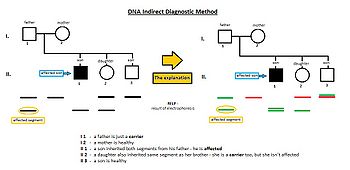DNA Diagnostic Indirect Methods
DNA indirect methods are based on an examination of probands (person being examined) family. The main instrument here is a pedigree. All we need is a sample of blood from a close family – proband, his parents, siblings and so on.
The sample of 10 ml of blood is enough. We extract the white blood cells – leucocytes. DNA is extracted from them. The next step is the use of Southern blotting. It is a method which allows us to divide the DNA due to restriction endonucleasis. They should then be lined according to their size.
DNA Probes[edit | edit source]
In indirect methods we used two types of probes – intragenetic or extragenetic. The probe is a segment of the DNA or RNA which binds specifically to some part of the DNA strand. The probes can be synthesized in the laboratory. It depends just on the targets DNA nucleotide sequence. It is an easy way how to find some specific part of the DNA, which can be associated with some disease under investigation.
The first type of probes – intragenetic – is located right on the spot of the examined gene. The second type – extragenetic – lies just close to it. In that case we can use our knowledge about a gene linkage. It can highly influence the results of the test.
Test Results[edit | edit source]
After the DNA is synthesized and the probes bind, we can discuss the results. The most important is to identify which segment of DNA was inherited from which parent. We can put the results of the electrophoresis into the scheme of the family tree. If we are able to determine an origin of inherited DNA segments – the family is called to be informative. In case of intragenetic probe we can be sure about the result (positive or negative). On the other hand the extragenetic probe´s results are just highly probable.
Another situation is the case, when we can´t say from which parent the segment was inherited. The family is then called to be uninformative. This method is based on the differences of RFLP in a population. This time we have to use another type of restriction endonucleasis. The result can then became informative.
The Use of DNA Indirect Methods[edit | edit source]
It is used for a prenatal diagnosis of inherited diseases. It is necessary to know, which segment of DNA is connected with it. According to its location we then synthesize a suitable probe - with suitable nucleotide sequence. Within the finding of affected fetuses we are also able to determine the carriers of the disease.
Links[edit | edit source]
Related articles[edit | edit source]
Bibliography[edit | edit source]
- SOUKUPOVÁ, SOUKUP,, et al. Kapitoly z lékařské biologie a genetiky II. 2. edition. 2005. ISBN 80-7184-581-7.


